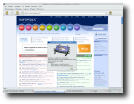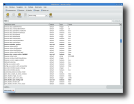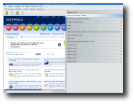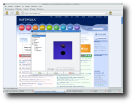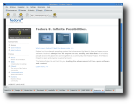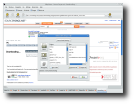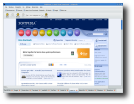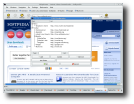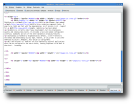One of the most used applications these days, along with e-mail clients, word processors and instant messengers, are the web browsers. There are a few popular ones, such as Firefox, Opera or Flock (which is specialized on social networks). Besides these three, there are a few others, like Konqueror, Dillo, or SkipStone. Today, I'll be talking about SkipStone, a small GTK+ browser, based on Mozilla's Gecko layout engine. From the version I'm reviewing, 1.0.0, support for the Apple WebKit rendering engine has been added, but it's recommended to use SkipStone with Gecko, because WebKit is still in development. Skipstone was first started in 2000, way back when Firefox didn't exist, but its "ancestor" Mozilla was one of the main browsers at that time.
After installing SkipStone, by using a .deb file for Ubuntu 7.10, I launched it and I wasn't very impressed at first. It's not the most beautiful web browser, but that can be changed, by using themes. The default one resembles those from Mozilla, so if you are nostalgic for the times when you used Mozilla, you might like this feature. I wasn't impressed by the looks, but the speed of opening up pages was very fast, I think it's almost as fast as Firefox 2.0.12.
Being used to the key bindings from Firefox, I pressed Ctrl+T and waited for a new tab to appear. Nothing happened, so I decided to look through the menus and see the keyboard shortcuts. Skipstone doesn't use the common key combos, which is a disadvantage for a user that got used to those from popular web browsers. For example, to open up a new tab in SkipStone, you have to press Alt+N. When I was looking for the key bindings, I found an option to save current session, which is a good feature, if you have a lot of tabs opened up and you want to recover them the next time you start up SkipStone. Speaking of tabs, by default they are positioned in the lower part of the window, just under the pages you open up. If you are not satisfied by this position, you can move them in the upper, right, or left side of the window, by going to Settings -> Notebook tabs. Because SkipStone pre-dates Firefox, the keyboard shortcuts are different, and it is one of the first web browsers that used tabs.
I've moved the tabs on the right side of the window, and I started opening up web sites. When I went on one with a long title, the tab bar occupied more than half of the entire window, and there was no way to resize it, at least not by dragging the margins to the desired place. So, I thought there should be an option somewhere in the Settings menu. I was right, there was such an option! In Settings -> Preferences -> Misc, I clicked on the radio button that said "Shorten Tab Names". For the moment, nothing happened, the tab names were as long as before. I closed the browser, and started it again, to see if anything happened. Now, the tab names were shortened, thus offering more space for the web pages. There should be something that announces the user that SkipStone needs to restart so the changes take effect, something similar to the way Firefox does this.
I launched 16 tabs in SkipStone and 16 in Firefox, to see how much memory "eats" each of them. In the first test, Firefox took up 10 more megabytes than SkipStone, but in the second the situation changed, as Skipstone used with 30 MB more than Firefox. I don't know why this fluctuates, because I've used the same sites and the same number of tabs in both of the tests.
When I was playing around with it, I found something in the Settings menu that allows a user to switch to windowed view, where every tab is opened in separate windows. As I had a big number of tabs, I got scared that this would take up a large chunk of memory, and my computer might get stuck. That's why I quickly went to the menu and switched back to tabbed view. The nice thing about this feature is that all tabs are regrouped in the same window, in the same order you had them before. When you close the program, you are not asked by it if you want to do that, like Firefox does. Maybe in a future release, this feature will be included, because it's necessary to avoid situations when you click by accident on the close button.
SkipStone has a bookmarking system, with its own agent. The system is tree-like, with directories and bookmarks. The agent is very simple, too simple in my opinion. It is so simple, that you can't even right click in the bookmark list! If this was allowed, a user could manage his/her bookmarks much faster; for example, when one wants to delete a bookmark, he/she would only have to right click on an item and then select "delete". There are only a few buttons in the agent, for adding, removing and updating the bookmarks.
A download manager is included in SkipStone, and bears the name "SkipDownload". Actually, it is a graphical interface to the wget downloading tool. When you start a download, two windows will appear, one with the progress of the current download, and the other showing the download queue. I think the developers should find a way to combine the two, and make a single window, because this will simplify SkipStone much more and make it better.
There's no password manager in SkipStone included by default, so if you visit a lot of sites and have different usernames and passwords, this will be a big problem for you, encumbering your navigation. But don't despair! SkipStone remembers your passwords! Also, if you want to have them displayed, you will have to install a plugin that works as a password manager. Speaking of navigation, when you complete the address field, there's no automatic filling, like in other browsers, but there's a drop down menu from which we can select the desired web page we previously visited. If you decide to stay on the current page, SkipStone will reload it, which is an odd behavior from my point of view. I don't think it's necessary to refresh the site, as long as the user doesn't click on Reload or presses "Alt+R" (the key shortcut for refresh). However, a plugin called Auto Completer, exists in the source package, so you can install it and have the autocompletion feature included in the browser.
The Good:
The best thing about SkipStone is the fact that it opens up web pages very fast. Also, its own start-up time is very reduced, in comparison with other web browsers.
The Bad:
It still needs a lot of polishing, especially in the bookmarking, usability and download areas. The themes should be also made to look like a modern browser, not to send a user back in time.
The Truth:
SkipStone is developed by only two persons, while other browsers have entire armies of coders behind them. I think SkipStone could be transformed in a much better browser, if more persons got involved in it. I am sure that with WebKit it will run much faster, and I am waiting for the version that will use WebKit as its web page rendering engine to see how it will act.
Here are some screenshots with SkipStone in action:
 14 DAY TRIAL //
14 DAY TRIAL // 
